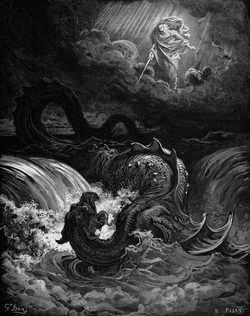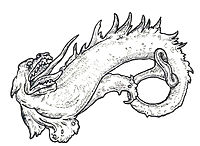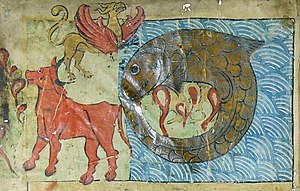Leviathan
From Wikipedia, the free encyclopedia

Leviathan (Hebrew: לִוְיָתָן, Standard Livyatan Tiberian Liwyāṯān ; "Twisted; coiled"), pronounced /lɨˈvaɪəˌθɑn/, is a Biblical sea creature referred to in the Old Testament (Psalm 74:13-14; Job 41; Isaiah 27:1). The word leviathan has become synonymous with any large sea monster or creature. In the novel Moby-Dick it refers to great whales, and in Modern Hebrew, it means simply "whale".
Contents |
[edit] Judaism
The word "Leviathan" appears in five places in the Bible, with the Book of Job, chapter 41, being dedicated to describing Leviathan in detail:
- Book of Job 3:8 "May those who curse days curse that day, those who are ready to rouse Leviathan "; NIV
- Book of Job 41: "Can you pull in the leviathan with a fishhook or tie down his tongue with a rope? Can you put a cord through his nose or pierce his jaw with a hook? ...Can you fill his hide with harpoons or his head with fishing spears?" NIV
- Psalms 74:14: "It was you who crushed the heads of Leviathan and gave him as food to the creatures of the desert." NLT
- Psalms 104:24-26: "O Lord, what a variety of things you have made! In wisdom you have made them all. The earth is full of your creatures. Here is the ocean, vast and wide, teeming with life of every kind, both large and small. See the ships sailing along, and Leviathan, which you made to play in the sea. NLT
- Isaiah 27:1: "In that day the LORD with His severe sword, great and strong, Will punish Leviathan the fleeing serpent, Leviathan that twisted serpent; And He will slay the reptile that is in the sea." NKJV
The word Leviathan is also mentioned in Rashi's commentary on Genesis 1:21: "God created the great sea monsters - Taninim." Jastrow translates the word "Taninim" as "sea monsters, crocodiles or large snakes". Rashi comments: "According to legend this refers to the Leviathan and its mate. God created a male and female Leviathan, then killed the female and salted it for the righteous, for if the Leviathans were to procreate the world could not stand before them."
The festival of Sukkot (Festival of Booths) concludes with a prayer recited upon leaving the sukkah (booth): "May it be your will, Lord our God and God of our forefathers, that just as I have fulfilled and dwelled in this sukkah, so may I merit in the coming year to dwell in the sukkah of the skin of Leviathan. Next year in Jerusalem."
A commentary on this prayer in the Artscroll prayer-book (p. 725) adds: "The Leviathan was a monstrous fish created on the fifth day of Creation. Its story is related at length in the Talmud Baba Bathra 74b, where it is told that the Leviathan will be slain and its flesh served as a feast to the righteous in [the] Time to Come, and its skin used to cover the tent where the banquet will take place."
There is another religious hymn recited on the festival of Shavuot (celebrating the giving of the Torah), known as Akdamut, wherein it says: "...The sport with the Leviathan and the ox (Behemoth)...When they will interlock with one another and engage in combat, with his horns the Behemoth will gore with strength, the fish [Leviathan] will leap to meet him with his fins, with power. Their Creator will approach them with his mighty sword [and slay them both]." Thus, "from the beautiful skin of the Leviathan, God will construct canopies to shelter the righteous, who will eat the meat of the Behemoth [ox] and the Leviathan amid great joy and merriment, at a huge banquet that will be given for them." Some rabbinical commentators say these accounts are allegorical (Artscroll siddur, p. 719), or symbolic of the end of conflict.
In a legend recorded in the Midrash called Pirke de-Rabbi Eliezer it is stated that the fish which swallowed Jonah narrowly avoided being eaten by the Leviathan, which generally eats one whale each day. In a hymn by Kalir, the Leviathan is a serpent that surrounds the earth and has its tail in its mouth, like the Greek Ouroboros and the Nordic Midgard Serpent.
Legend has it that in the banquet after the end of conflict, the carcass of the Leviathan will be served as a meal, along with the Behemoth and the Ziz. Leviathan may also be interpreted as the sea itself, with its counterparts Behemoth being the land and Ziz being the air and space.
The Biblical references to Leviathan have similarities to the Canaanite Baal cycle, which involving a confrontation between Hadad (Baal) and a seven headed sea monster named Lotan. Lotan is the Ugaritic orthograph for Hebrew Leviathan. Hadad defeats him. Bibilical references also resemble the Babylonian creation epic Enûma Elish in which the storm god Marduk slays his grandmother, the sea monster and goddess of chaos and creation Tiamat and creates the earth and sky from the two halves of her corpse.
[edit] Leviathan in rabbinic literature
[edit] Creation of Leviathan
According to most ancient Jewish midrash, the Leviathan was created on the fifth day (Yalkut, Gen. 12). Originally God produced a male and a female leviathan, but lest in multiplying the species should destroy the world, He slew the female, reserving her flesh for the banquet that will be given to the righteous on the advent of the Messiah (B. B. 74b).
[edit] Size
The enormous size of the Leviathan is thus illustrated by R. Johanan, from whom proceeded nearly all the haggadot concerning this monster: "Once we went in a ship and saw a fish which put his head out of the water. He had horns upon which was written: 'I am one of the meanest creatures that inhabit the sea. I am three hundred miles in length, and enter this day into the jaws of the Leviathan'" (B. B. l.c.). When the Leviathan is hungry, reports R. Dimi in the name of R. Johanan, he sends forth from his mouth a heat so great as to make all the waters of the deep boil, and if he would put his head into paradise no living creature could endure the odor of him (ib.). His abode is the Mediterranean Sea; and the waters of the Jordan fall into his mouth (Bek. 55b; B. B. l.c.).
The body of the Leviathan, especially his eyes, possesses great illuminating power. This was the opinion of R. Eliezer, who, in the course of a voyage in company with R. Joshua, explained to the latter, when frightened by the sudden appearance of a brilliant light, that it probably proceeded from the eyes of the Leviathan. He referred his companion to the words of Job xli. 18: "By his neesings a light doth shine, and his eyes are like the eyelids of the morning" (B. B. l.c.). However, in spite of his supernatural strength, the leviathan is afraid of a small worm called "kilbit", which clings to the gills of large fishes and kills them (Shab. 77b).[1]
[edit] Other
In a legend recorded in a Midrash called Pirke de-Rabbi Eliezer it is stated that the whale which swallowed Jonah narrowly avoided being eaten by the Leviathan, which generally eats one whale each day.
[edit] Talmudic references
In the Talmud, the Leviathan is mentioned a number of times:
Avoda Zara (3b): "Rav Yehuda says, there are twelve hours in a day. The first three hours God sits and learns the Torah, the second three hours he sits and judges the world. The third three hours God feeds the entire world... the fourth three hour period God plays with the Leviathan as it is written: "the Leviathan which you have created to play with"".[2]
Moed Katan (25b): "Rav Ashi said to Bar Kipok: what will be said at my funeral? He answered: "If a flame can fall a cedar, what hope does a small tree have? If a Leviathan can be hooked and hauled to land, what hope has a fish in a puddle?" [3]
[edit] Christianity
The Christian interpretation of Leviathan is often considered to be a demon or natural monster associated with Satan or the Devil, and held by some to be the same monster as Rahab (Isaiah 51:9).
Some biblical scholars considered Leviathan to represent the pre-existent forces of chaos. In Psalm 74:13-14 it says "it was You who drove back the sea with Your might, who smashed the heads of the monsters in the waters; it was You who crushed the heads of Leviathan, who left him as food for the creatures of the wilderness. (JPS edition)" God drove back the waters of the Earth (Genesis 1:2 "And the earth was formless and void, and darkness was over the surface of the deep, and the Spirit of God was moving over the surface of the waters." ([NAS])

A number of interpreters suggest that Leviathan is a symbol of mankind in opposition to God, claiming that it and beasts mentioned in the books of Daniel and Revelation should be interpreted as metaphors. The usage of Leviathan in the Old Testament books (Isaiah 27:1) would seem to be a reference to a Semitic mythological beast mentioned in literature of Ugarit, a city-state in North Syria. According to Canaanite myth, the Leviathan was an enemy of order in Creation and was slain by the Canaanite god Baal. The word Leviathan to the ancient Jews became synonymous with that which warred against God's kingdom. This especially included nations warring against Israel such as Assyria and Egypt. (The Bible Knowledge Commentary, Old Testament,1985, SP Publications Inc.)
Leviathan also appears in the Book of Enoch, giving the following description of this monster's origins there mentioned as being female, as opposed to the male Behemoth:
And that day will two monsters be parted, one monster, a female named Leviathan in order to dwell in the abyss of the ocean over the fountains of water; and (the other), a male called Behemoth, which holds his chest in an invisible desert whose name is Dundayin, east of the garden of Eden. - 1 Enoch 60:7-8

Leviathan became associated, and may have originally been referred to, in the visual motif of the Hellmouth, a monstrous animal into whose mouth the damned disappear at the Last Judgement, found in Anglo-Saxon art from about 800, and later all over Europe.[4][5]
According to St. Thomas Aquinas, Leviathan is the demon of envy and the demon who is first in punishing the corresponding sinners.
Leviathan is also sometimes said to have been of the order of Seraphim. According to the writings of Father Sebastien Michaelis, Balberith, a demon who allegedly possessed Sister Madeleine at Aix-en-Provence, obligingly told the priest not only the other devils possessing the nun, but added the special saints whose function was to oppose them. Leviathan was one devil that was named and was said to tempt men into committing sacrilege. Its adversary was said to be St. Peter.
In The Marriage of Heaven and Hell, William Blake wrote:
- But now, from between the black & white spiders, a cloud and fire burst and rolled thro' the deep black'ning all beneath, so that the nether deep grew black as a sea, & rolled with a terrible noise; beneath us was nothing now to be seen but a black tempest, till looking east between the clouds & the waves, we saw a cataract of blood mixed with fire, and not many stones' throw from us appear'd and sunk again the scaly fold of a monstrous serpent; at last, to the east, distant about three degrees appear'd a fiery crest above the waves; slowly it reared like a ridge of golden rocks, till we discover'd two globes of crimson fire, from which the sea fled away in clouds of smoke; and now we saw, it was the head of Leviathan; his forehead was divided into streaks of green & purple like those on a tyger's forehead: soon we saw his mouth & red gills hang just above the raging foam tinging the black deep with beams of blood, advancing toward us with all the fury of a spiritual existence.
[edit] Leviathan as an animal
In the book of Job, both Behemoth and Leviathan are listed alongside a number of other animals that are clearly mundane, such as goats, eagles, and hawks, leading some Christian scholars to surmise that Behemoth and Leviathan may also be mundane creatures. Some propose Leviathan was a Nile crocodile. Like the Leviathan, the Nile crocodile is aquatic, scaly, and possesses fierce teeth. Job 41:18 states that Leviathan's eyes "are like the eyelids of the morning". Others suggest that the Leviathan is an exaggerated account of a whale.
Some Young Earth Creationists have alleged that Leviathan was either a dinosaur, such as Parasaurolophus (despite being a herbivore and a non-aquatic animal), or a giant marine reptile, such as Kronosaurus (despite lacking armor and a serpentine body).[6] Other Young Earth Creationists is that the giant crocodilian, Sarcosuchus, best fits the description in the Bible.[7]
MaIn Job chapter 41 Leviathan is described as breathing fire like a dragon, and none of these suggested animals breathe fire or fit the details of other Bible passages mentioning Leviathan, such as in the book of Psalms.
[edit] Leviathan in literature
Leviathan is the title of Thomas Hobbes' 1651 work on the social contract and the origins of creation of an ideal state, and his proper name for the Commonwealth.
In Paradise Lost, Milton uses the term Leviathan to describe the size and power of Satan, the ruler of many kingdoms.
Partly due to the influence of Herman Melville's classic, Moby-Dick, the Leviathan has come to be associated by many with the sperm whale. An example of this is in Disney's depiction of Pinocchio's being swallowed by Monstro, a sperm whale, despite the fact that in the original Italian book Pinocchio was swallowed by a "Pesce-cane", translated as "dog-fish" or "shark".
[edit] Leviathan in Satanism
Leviathan was also used in Satanism by the occult author, Anton LaVey, to represent the element of Water and the direction of West. The element of Water in Satanism is associated with life and creation, and may be represented by a Chalice. [8] In the Satanic Bible, Leviathan is listed as one of the Four Crown Princes of Hell.[9] This association was inspired by the demonic hierarchy from The Book of the Sacred Magic of Abra-Melin the Mage.
[edit] See also
- Christian demons in popular culture
- Adamastor
- Aspidochelone
- Behemoth
- Jormungandr
- Kraken
- Lotan
- Tarasque
- Ziz
- Theli (dragon)
- Rahab
- List of monsters
- Hecate
- Lilith
- Tiamat
[edit] Notes
- ^ http://www.jewishencyclopedia.com/view.jsp?artid=275&letter=L
- ^ June 26, 2005
- ^ REVIEW ANSWERS - MOED KATAN 25
- ^ The Devil: A Mask Without a Face Luther Link, pp. 75-6, Reaktion Books, 1995, ISBN 0948462671
- ^ Petra Hofmann (thesis)Infernal Imagery in Anglo-Saxon Charters, p. 143-4, St Andrews, 2008
- ^ Gish, Duane, 1977. Dinosaurs those Terrible Lizards. San Diego: Creation-Life Publishers, pp. 30, 51-54.
- ^ Was Leviathan a Parasaurolophus? title
- ^ http://www.spiritualsatanist.com/articles/magick/ritualtools.html
- ^ http://www.dpjs.co.uk/crownprinces.html
[edit] References
- This article incorporates text from the 1901–1906 Jewish Encyclopedia, a publication now in the public domain.
[edit] External links
| Look up Leviathan in Wiktionary, the free dictionary. |
- Putting God on Trial- The Biblical Book of Job contains a major section on the literary use of Leviathan.
- Enuma Elish (Babylonian creation epic)
- Philologos concordance page


